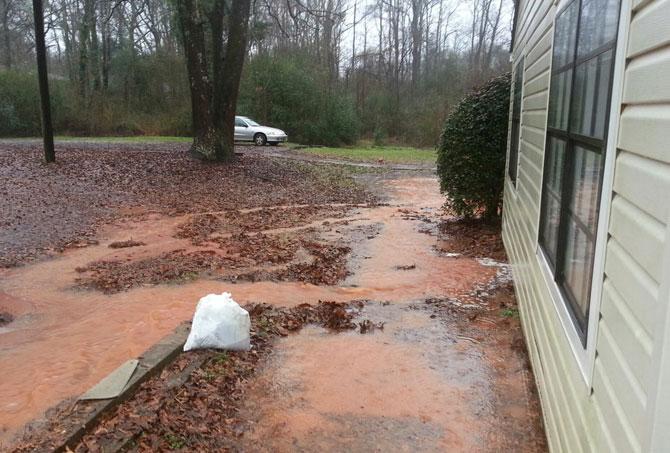Airport Torrent

Photo Credit: Adam Neely
The morning of Jan. 11, Katie Carmody and Adam Neely stepped out of their duplex near Athens-Ben Epps Airport to see a steady flow of water bringing silt, red clay and other debris into their yard.
“The dirt they put in the ditch was just loose red clay, basically,” Neely says. “So when the rain happened, all the water came down from the airport and hit that ditch. There was like a rapid of brown, Georgia clay water coming down the driveway, down by my car.”
Athens-Clarke County Public Utilities was completing work on water lines near the O’Kelly Road residence, and Neely says he believes the work site was not prepared for any sort of rainfall. “The ditches from where the water was coming down—they’re not even real ditches,” Neely says. “They come down this road, and when they get to the end, which is where my driveway is, it just comes up to the ground level. They weren’t dug out.”
After the rainstorm, which brought around three inches of rain in a 24-hour period, water runoff from the airport runway combined with water and silt on the ground, leading to a flood in Neely’s front yard.
Tim Beggerly, director of the airport, says he thinks the high quantity of rain led to the issue. “There were flood warnings that weekend, and there was three inches of rain in a 24-hour period,” Beggerly says. “Normally that wouldn’t happen, and I think more than placing blame on a department for a project that wasn’t done properly, I think everything appeared to be done properly. It was just the fact that there was so much rain in such a short period of time.”
Neely, however, says the issue was caused by a combination of the utility work and the airport’s runoff.
“The airport guys kept reinforcing that the sediment didn’t come from their property, and I know it’s like, 'I really don’t care if the mud came from your property,'” Neely says. “The water came, and that was what mixed with all the mud from the drainage ditch. It was definitely a combination of the two, but even if there hadn’t been mud coming down, the water would have done about the same thing.”
Jamie Lewis, an environmental project manager for Georgia Department of Agriculture, was called to O’Kelly Road to make sure no muddy water was running off from construction of a runway expansion.
“What we deal with with construction sites is we look for, making sure they’re not discharging muddy water and stuff, and putting mud and sediment off-site,” Lewis says. “That’s what I went to take a look at… A lot of the water that was coming off that airport site was clean water, so that’s where my authority would end as far as that construction site.”

Photo Credit: Adam Neely
Lewis says the airport construction likely did not lead to an increased amount of water in Neely and Carmody’s yard. The flooding likely occurred from a blockage in the water's usual path to the creek.
“I do believe one of the issues that was dealing with this individual and the reason they got flooded out was because of the drainage from the roadway was not allowed to go historically to the area next to their home,” Lewis said. “It would normally go into the creek. And that’s the reason why these homes were flooded—because the pathway for that water, for whatever reason, closed up and sediment basically settled out and caused the water to go to the left and go to their property.”
Even though the problem was not caused by the airport, Beggerly says he remained involved in getting the issue resolved. "I hate to keep pointing to someone else, saying ‘Oh, it’s not our problem, it’s their problem,’ so that’s why I stayed involved. Because I wanted to make sure it was taken care of,” he says. “[The duplexes have] always been a good neighbor to the airport, because they live right off the end of the runway here, literally right off the end of the runway. But they’ve been very good neighbors to us, so I wanted to reciprocate that to him too.”
Jerry Oberholtzer, engineering administrator for the Transportation and Public Works Department, says after a complaint about silt buildup came in, stormwater inspectors and land development executors were sent to the worksite.
“It’s a dirt road, and we do maintain that, and what happened was the ditch got silted up,” Oberholtzer says. “We’re in the process of going out there and cleaning up the ditch and providing positive drainage back to the creek. We’re working with that with our street crews.”
The contractor of the utility work would typically be in charge of sodding the area once construction is complete, but Oberholtzer says public works became involved in this situation because the silt caused a maintenance issue.
“We went out there, and we’ve been working with public utilities to get that stabilized,” Oberholtzer says. “And we’re going to go back and do some rehabilitation of the ditch up there.”
Rehabilitation of the ditch includes sodding or placing grass in the ditch to reduce future problems with silt. Oberholtzer says silt removal will be completed “as quickly as the weather allows.” Cold weather and snow make it more difficult to establish grass or sod in an area.
The issue has been resolved from Neely’s point of view, he says, but it took almost two weeks to fix. And as precipitation levels have been more moderate, there remains a question if the correction will hold against another bout of heavy rain.
“All the stuff they’ve done, it’s not like they have an engineer down here trying to figure it out,” Neely says. “The city people came out; they put some rocks in the ditch. They tried to dig out the ditch a little further. It’s standard stuff, I guess, you would do, but none of it seems really thought out.”
Keywords
More by Erica Techo
-

-

Police See a Rise in Georgia Fentanyl Deaths
The prescription painkiller took the life of UGA student David Braun.
-










comments